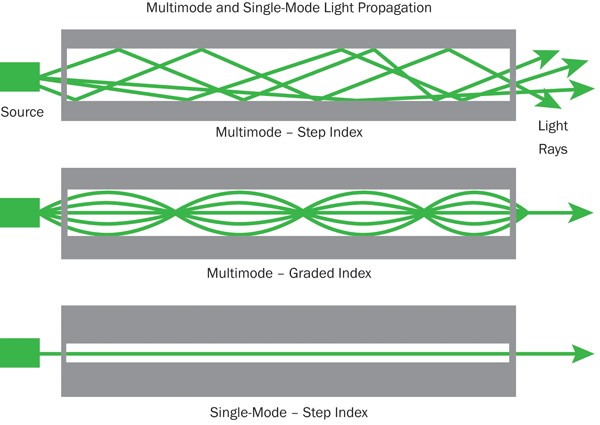With
bandwidth demand increasing in enterprise and data center networks, the
system designers may believe that single-mode fiber enjoys an
increasing advantage over multimode fiber in premises applications. But
higher Ethernet speeds do not automatically mean that single-mode fiber
is the right choice even though it holds advantages in terms of
bandwidth and reach for longer distances. Multimode fiber can easily
support most distance requirements in enterprise and data center
networks, and it is a more cost-effective choice over single-mode fiber
for the shorter reach applications. So single-mode fiber and multimode fiber, which one to choose?
Differences Between Single-mode Fiber and Multimode Fiber
At
the very first beginning, let’s make clear the differences between
single-mode fiber and multimode fiber. Generally, single-mode fibers
have a small core size (<10 µm) that permits only one mode or ray of
light to be transmitted. This tiny core requires precision alignment to
inject light from the transceiver into the core, significantly driving
up transceiver costs. By comparison, multimode fibers have larger cores
(62.5 µm or 50 µm) that guide many modes simultaneously. The larger core
makes it much easier to capture light from a transceiver, allowing
source costs to be controlled.

Similarly,
multimode connectors cost less than single-mode connectors as a result
of the more stringent alignment requirements of single-mode fiber.
Single-mode connections require greater care and skill to terminate,
which is why components are often pre-terminated at the factory. On the
other hand, multimode connections can be easily performed in the field,
offering installation flexibility, cost savings and peace of mind.
The
light propagation between single-mode fiber and multimode fiber is
totally different. Multimode fiber has two types of light
propagation—step index and graded index, while single-mode fiber has
only one step index. And the light propagation reduces less in the
single-mode fiber’s transmissions than that of multimode fiber.

The following table shows the main differences between single-mode fiber and multimode fiber.

How to Choose One Over the Other?
Choosing
the single-mode fiber or multimode fiber is based on your transmission
distance need and the overall budget allowed. Single-mode fiber is
normally used for long distance transmissions with laser diode based
fiber optic transmission equipment, while multimode fiber is usually
used for short distance transmissions with LED based fiber optic
equipment. If the distance is less than a couple of miles, multimode
fiber will work well. And the transmission costs, including both
transmitter and receiver sides, will be in the range of $ 500 to $ 800.
If the distance to be covered is more than 3-5 miles, single-mode fiber
is the choice. And the transmission systems designed for use with
single-mode fiber will typically cost more than $ 1000 due to increased
cost of the laser diode.
Conclusion
Generally,
multimode fiber is more cost-effective choice for data center
applications up to 550 meters. Single-mode fiber is best used for
distances exceeding 550 meters. Besides the transmission distance, the
overall cost should also be taken into consideration. Whether
single-mode fiber or multimode fiber, choosing the one that best suits
your network is the smartest choice.
Originally published: www.fiberopticshare.com
没有评论:
发表评论